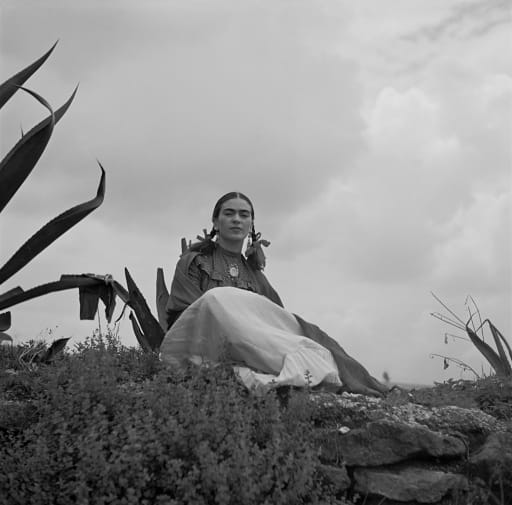In honour of Pride Month and Pride Inside, we highlight some of UAL’s research outlets surrounding the expression of identity through fashion and dress.
Pride Inside runs 27 June – 10 July and is organised by UK Black Pride, Amnesty International UK, ParaPride and Gendered Intelligence, with support from Stonewall. UK Black Pride's programme on Pride Inside runs from 2 – 5 July - further details on Twitter.
Dress shaping identity
Dress is autobiographical, not only when it is worn, but also when it is designed, documented and exhibited over time. We look at research that celebrates the role that fashion and dress play in expressing identity, especially when communicating something that is marginalised or hidden.
Frida Kahlo: Making Her Self Up
A rebellious Mexican painter known for her self-portraits addressing identity, queerness and the body, Frida is an important figure in the LGBTQ+ community, art and fashion industries.
In 2018, the Victoria and Albert Museum presented ‘Frida Kahlo: Making Her Self Up’, curated by UAL’s Clare Wilcox, chair in Fashion Curation at London College of Fashion. The exhibition displayed the artist’s clothing and personal belongings (often featured in her paintings) that were seen for the first time outside of Mexico, 50 years after her death.
Born in 1907 into a machismo culture with strict gender roles, it was unusual for a young woman like Frida to have fluid and progressive ideas surrounding sexuality. She was both contemporary and provocative, in the sense that she was queer, disabled, gender fluid and a communist. Kahlo’s distinctive look was rebellious in itself. She possessed strong features that she celebrated by accentuating her unibrow and moustache in her self-portraits – challenging notions of traditional feminine beauty.
Kahlo proudly wore her indigenous Tehuana dress to celebrate her Mexican heritage, but also to cover her legs, one of which was thinner and shorter due to catching polio as a child. Her Tehuantepec garments allowed her to powerfully express herself whilst masking her disability, which in a chauvinistic world, gave her confidence to exercise her political voice and status. It is in this way that Frida’s dress was autobiographical, as it enabled her to express her identity and at times conceal it for her own activism.
After the V&A, the exhibition toured Brooklyn Museum and was due to continue to de Young Museum in San Fransisco, but subsequently became unavailable to the public because of lockdown.
In response to lockdown, Google Arts and Culture made an 800-piece collection of Frida-related material available online, including a piece on the 2012 The Blue House exhibition which began UAL’s involvement in the V&A exhibit. Curated by Judith Clark, Professor of Fashion and Museology at LCF, and Circe Henestrosa, the original ‘Appearances Can Be Deceiving’ exhibit is included, and is available to view online on Google’s Face’s of Frida.
‘Gluck: Art and Identity’
The Centre for Fashion Curation (CfFC) worked alongside the Brighton Museum on the 2017–2018 exhibition ‘Gluck: Art and Identity’ based on the life of Sussex-based 20 Century artist Hannah Gluckstein (1895 – 1978).
Hannah Gluckstein was a British painter who adopted the name ‘Gluck’ and rejected the use of any forenames like ‘Miss’ – since she too was gender non-conforming. The exhibition focused on the artist’s biography, garments, ephemera and artworks. Using dress to reconstruct gendered identity, Gluck also defined convention by wearing masculine-style tailored clothing, sporting barber-cut short hair and a masculine demeanor in order to make herself powerful.
Widely recognized as a trailblazer of gender fluidity, Gluck was born into a wealthy Jewish family and attended St John’s Wood School of Art in London before running away to Cornwall with fellow artists during the First World War.
The exhibition was part of UAL’s 'Wear it Out’ project that explored the culture heritage of the dress of LGBTQ+ communities in Sussex (1917 – 2017). The project looked at how dress is used autobiographically to express identities and sexualities of individuals who identify as LGBTQ+.
Masculinities Hub
Coordinated by LCF’s Charlie Athill, Jay McCauley Bowstead and Ruth Miller, UAL’s Masculinities Hub brings together practitioners and theorists interested in all aspects of menswear and masculinities.
Born from gender studies and queer theory, the research covers a range of topics including media, imagery, business, production, age, race, gender, sexuality and the body. The hub strives to engage with menswear while exploring the future of masculinities in a broad range of cultural contexts.
Among other avenues, the Masculinities Hub looks at the fashion cultures of locales who are under-represented in existing scholarship, and the globalisation and hybridity in the design and production of men’s fashion. With the globalisation of masculinities at the forefront, their conference ‘Globalising Men’s Style’ will be taking place on Blackboard Collaborate on 21 – 23 July.
Image: Frida Kahlo seated next to an agave plant, during a photo shoot for Vogue magazine, "Senoras of Mexico" by Toni Frissell. Source : Toni Frissell collection, Library of Congress
Related links:
- For more information on ‘Frida Kahlo: Making Her Self Up’ exhibition and UAL’s role, explore Unveiling Frida Kahlo.
- Masculinities Hub
- Globalising Men’s Style
- ‘Gluck: Art and Identity’
- Wear it Out: University of the Arts London, funded by Heritage Lottery Fund.

